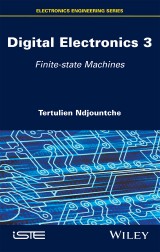Details

Digital Electronics 3
Finite-state Machines1. Aufl.
|
139,99 € |
|
| Verlag: | Wiley |
| Format: | |
| Veröffentl.: | 20.10.2016 |
| ISBN/EAN: | 9781119371144 |
| Sprache: | englisch |
| Anzahl Seiten: | 336 |
DRM-geschütztes eBook, Sie benötigen z.B. Adobe Digital Editions und eine Adobe ID zum Lesen.
Beschreibungen
<p>This third volume in the comprehensive Digital Electronics series, which explores the basic principles and concepts of digital circuits, focuses on finite state machines. These machines are characterized by a behavior that is determined by a limited and defined number of states, the holding conditions for each state, and the branching conditions from one state to another. They only allow one transition at a time and can be divided into two components: a combinational logic circuit and a sequential logic circuit.<br />The approach is gradual and relatively independent of each other chapters. To facilitate the assimilation and practical implementation of various concepts, the book is complemented by a selection of practical exercises.</p>
<p>Preface ix</p> <p><b>Chapter 1. Synchronous Finite State Machines 1</b></p> <p>1.1. Introduction 1</p> <p>1.2. State diagram 2</p> <p>1.3. Design of synchronous finite state machines 6</p> <p>1.4. Examples 7</p> <p>1.4.1. Flip-flops 7</p> <p>1.4.2. Binary sequence detector 12</p> <p>1.4.3. State machine implementation based on a state table 21</p> <p>1.4.4. Variable width pulse generator 22</p> <p>1.5. Equivalent states and minimization of the number of states 27</p> <p>1.5.1. Implication table method 28</p> <p>1.5.2. Partitioning method 37</p> <p>1.5.3. Simplification of incompletely specified machines 42</p> <p>1.6. State encoding 55</p> <p>1.7. Transformation of Moore and Mealy state machines 61</p> <p>1.8. Splitting finite state machines 63</p> <p>1.8.1. Rules for splitting 63</p> <p>1.8.2. Example 1 64</p> <p>1.8.3. Example 2 67</p> <p>1.9. Sequence detector implementation based on a programmable circuit 68</p> <p>1.10. Practical considerations 70</p> <p>1.10.1. Propagation delays and race conditions . 72</p> <p>1.10.2. Timing specifications 74</p> <p>1.11. Exercises 79</p> <p>1.12. Solutions 97</p> <p><b>Chapter 2. Algorithmic State Machines 169</b></p> <p>2.1. Introduction 169</p> <p>2.2. Structure of an ASM 169</p> <p>2.3. ASM chart 170</p> <p>2.4. Applications 175</p> <p>2.4.1. Serial adder/subtracter 175</p> <p>2.4.2. Multiplier based on addition and shift operations 183</p> <p>2.4.3. Divider based on subtraction and shift operations 187</p> <p>2.4.4. Controller for an automatic vending machine 189</p> <p>2.4.5. Traffic light controller 193</p> <p>2.5. Exercises 200</p> <p>2.6. Solutions 205</p> <p><b>Chapter 3. Asynchronous Finite State Machines 213</b></p> <p>3.1. Introduction 213</p> <p>3.2. Overview 214</p> <p>3.3. Gated D latch 214</p> <p>3.4. Muller C-element 218</p> <p>3.5. Self-timed circuit 220</p> <p>3.6. Encoding the states of an asynchronous state machine 224</p> <p>3.7. Synthesis of asynchronous circuits 227</p> <p>3.7.1. Oscillatory cycle 227</p> <p>3.7.2. Essential and d-trio hazards 228</p> <p>3.7.3. Design of asynchronous state machines 239</p> <p>3.8. Application examples of asynchronous state machines 240</p> <p>3.8.1. Pulse synchronizer 240</p> <p>3.8.2. Asynchronous counter 243</p> <p>3.9. Implementation of asynchronous machines using SR latches or C-elements 247</p> <p>3.10. Asynchronous state machine operating in pulse mode 251</p> <p>3.11. Asynchronous state machine operating in burst mode 256</p> <p>3.12. Exercises 258</p> <p>3.13. Solutions 266</p> <p>Appendix. Overview of VHDL Language 287</p> <p>A.1. Introduction 287</p> <p>A.2. Principles of VHDL 287</p> <p>A.2.1. Names 288</p> <p>A.2.2. Comments 288</p> <p>A.2.3. Library and packages 289</p> <p>A.2.4. Ports 289</p> <p>A.2.5. Signal and variable 289</p> <p>A.2.6. Data types and objects 289</p> <p>A.2.7. Attributes 290</p> <p>A.2.8. Entity and architecture 291</p> <p>A.3. Concurrent instructions 292</p> <p>A.3.1. Concurrent instructions with selective assignment 293</p> <p>A.3.2. Concurrent instructions with conditional assignment 293</p> <p>A.4. Components 294</p> <p>A.4.1. Generics 296</p> <p>A.4.2. The GENERATE Instruction 296</p> <p>A.4.3. Process 297</p> <p>A.5. Sequential structures 298</p> <p>A.5.1. The IF instruction 298</p> <p>A.5.2. CASE instruction 303</p> <p>A.6. Testbench 306</p> <p>Bibliography 311</p> <p>Index 313</p>
<p><b>Tertulien Ndjountche</b> received a PhD degree in electrical engineering from Erlangen-Nuremberg University in Germany. He has worked as a professor and researcher at universities in Germany and Canada. He has published numerous technical papers and books in his fields of interest.</p>

















